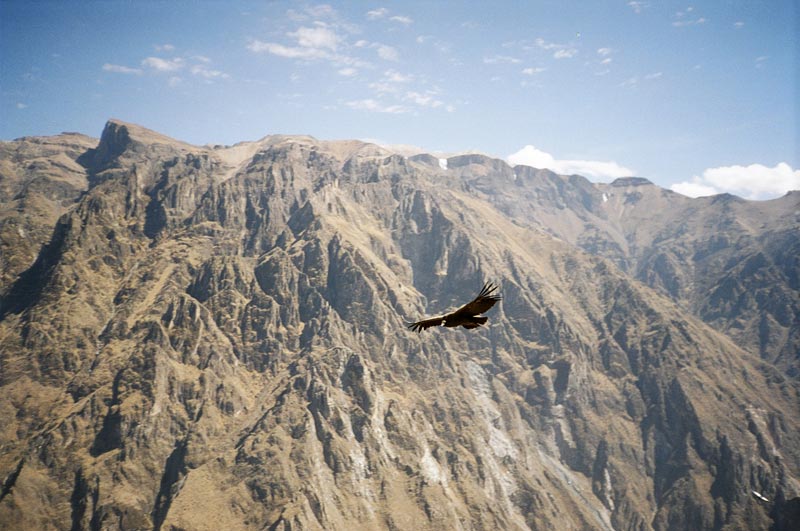Colca Canyon: "El Cóndor Pasa"
Day Two
Chivay – Colca Canyon – Arequipa
Peru
November 25. 2003
Dear Family and Friends,
The visit to Colca Canyon was the highlight of the long ride through the desert and the mountains.
After a light breakfast at a comfortable inn – hot, hot water, clean room, and cheerful staff – our group hit the road.
(Did I mention that in a few spots the road was actually paved?)
The route through the mountains is basically UP. Up and around, and up some more, and up and up through these stark gray rugged mountains. Until, finally, we are at the rim of Colca Canyon.
OK. Maybe I am lazy. I have decided to quote the guidebook:
“Colca Valley” Mario Vargas Llosa, the Peruvian novelist and the most famous Arequipeño, described Colca as “The Valley of Wonders.” That is no literary overstatement. Colca is one of the most scenic regions in Peru, a land of imposing snowcapped volcanoes, artistically terraced agricultural slopes, narrow gorges, arid desert landscapes and vegetation, and remote traditional villages, many visibly scarred by seismic tremors common in southern Peru.
The Colca River is one of the sources of the Amazon. It slices through the canyon, which remained largely unexplored until the mid-1970s, when rafting expeditions descended to the bottom of the gorge. Reaching depths of 3,400m (11,220 ft.) – twice as deep as the Grand Canyon – el Cañón del Colca forms part of a volcanic mountain range more than 100 km (62 miles) long.
Dispersed across the Colca Valley are fourteen colonial-era villages, which date to the 16th Century and are distinguished primarily by their small but often richly decorated churches.
Local populations in the valley, descendants of the Collaguas and Cabanas, pre-Inca ethnic communities, preserve ancient customs and distinctive dress. They speak different languages and can be distinguished by their hats; some women wear hats with colored ribbons, others have elaborately embroidered and sequined headgear. The valley’s meticulous agricultural terracing was first cultivated more than 1,000 years ago.
Cruz del Cóndor…or Condor Cross, about 50km (32 miles) west of Chivay, is a lookout point fast growing in fame. At a spot 1200m (3,960 ft.) above the canyon river, crowds gather, zoom lenses poised, to witness a stunning wildlife spectacle.
Beginning around 9:00am, Andean condors – the largest birds in the world, with wingspans of 3.5m (11.5 ft.) – begin to appear, circling far below in the gorge and gradually gaining altitude with each pass, until they literally soar silently above the heads of awestruck admirers.
Condors are such immense and heavy creatures that they cannot lift off from the ground; instead, they take flight from cliff perches. Each morning, from around 9:00 to 10:00 am or later, condors both young and mature glide and climb theatrically before heading out along the river in search of prey. To witness the condors’ majestic flight up close (the feathers at the end of their wings spread like fingers) is a mesmerizing sight, capable of producing goose bumps on even the most jaded travelers.”
So there you have it. “ Mesmerizing” may be a little over the top. And I am certainly not one of those “jaded travelers.” But I have to tell you, my friends, this was a beautiful day. And I guess that is part of my travel philosophy…”Have a beautiful day, every day.”
A beautiful day may be nothing more than sitting in a café with a cup of coffee, or visiting a grand cathedral, or feeding pigeons in the park or watching the largest birds in the world… close up and personal… Whatever….
The drive back was quiet. While I rode “shotgun” in the van, mis compañeros slept in the back. We did stop at a farmhouse for a photo op with a herd of llamas. Hey, they have an interesting defense mechanism. If you get too close they spit in your face! My Japanese buddy did get too close and he got quite a large and stinging wad in his eyes. I was luckier. I did manage to get close, but I guess those wooly creatures decided I looked a little friendlier.
And speaking of “friendly,” Peruvians are just that. This is a wonderful journey. Everyone has been hospitable and helpful.
My favorite moments have been when I am surrounded by large groups of happy and giggling high school boys and girls who are on class trips. They all want to have a picture with the “gringo” from the USA. I teach the boys “Dame cinco” and “Cinco alto.” The girls always ask me, “Donde están su esposa y sus niños?” (Where are your wife and children?) The giggling girls shriek with joy when I flash my flirtatious smile and answer, “Soy soltero.” (I am single.)
I will spend an extra day in Arequipa to see the sights and return to Vanessa and The Terrace restaurant for one more bowl of sopa criolla. Then I fly to the northeast city of Iquitos on the bank of the mighty Amazon.
Hasta luego,
Soltero Juan

